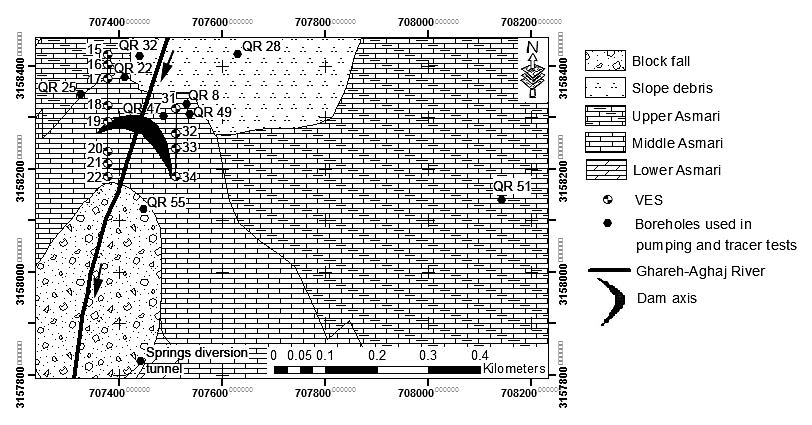Estimation of hdraulic conductivity using geoelectrical data for assessing of scale effect in a karst aquifer
DOI:
https://doi.org/10.3986/ac.v45i3.3632Keywords:
hydraulic conductivity, Karst, Scale effect, Vertical electrical sounding, IranAbstract
The Salman Farsi Dam was constructed on the Ghareh-Aghaj river in the catchment of the Asmari limestone aquifer, Changal Anticline, Zagros region, Iran. In order to estimate the hydraulic conductivity of the aquifer, combination of geoelectrical (i.e., bulk resistivity of the aquifer) and hydrophysical (i.e., electrical conductivity of groundwater) data are used as an alternative approach. Porosity of the aquifer is estimated based on the modified form of Archie’s empirical law assuming well-cemented carbonate rocks. Formation resistivity factor and critical pore size of the Asmari limestone aquifer are used for estimating the hydraulic conductivity on the small scale based on the Thompson Equation. The results suggest an average porosity and hydraulic conductivity of 14.4 % and 0.016 m/day, respectively. The estimated value for hydraulic conductivity is smaller than values previously determined for the aquifer, based on tracer, pumping and Lugeon tests. Comparison of the hydraulic conductivity obtained by different methods revealed scale effect of hydraulic conductivity measurements in the Asmari limestone aquifer. As a result, application of the geoelectrical and hydrophysical data can provide a cost-effective and efficient alternative to estimate hydraulic conductivity in karst aquifers on the small scale.
Keywords: hydraulic conductivity, Karst, Scale effect, Vertical electrical sounding, Iran.
Uporaba geoelektričnih podatkov za oceno hidravlične prevodnosti in učinka merila v kraškem vodonosnika
Jez Salman Farsi je postavljen na reku Ghareh-Aghaj v območju kraškega vodonosnika Asmari, ki pripada antiklinali Changal v gorovju Zagros, Iran. Hidravlično prevodnost vodonosnika smo ocenili z kombinacijo meritev celokupne električne upornosti vodonosnika in električne prevodnosti podzemne vode. Ocena poroznosti je temeljila na prilagojeni obliki Archiejevega empiričnega zakona, pri čemer smo predpostavili dobro cementirane karbonate. Iz upornosti formacije in kritične velikosti por smo s Thompsonovo enačbo izračunali hidravlično prevodnost v majhnem merilu. Dobljena povprečna poroznost tako znaša 14,4 %, povprečna prevodnost pa 0.016 m/dan. Vrednosti hidravlične prevodnosti so precej manjše of prej dobljenih vrednosti iz sledilnih, črpalnih in Lugeonovih poskusov, kar kaže na pomemben učinek merila v obravnavanem vodonosniku. Raziskava med drugim kaže na primernost geoelektričnih in hidrofizikalnih podatkov za stroškovno ugodno oceno hidravlične prevodnosti v majhnem merilu.
Ključne besede: Hidravlična prevodnost, kras, učinek merila, vertikalno električno sondiranje, Iran.
Downloads

Downloads
Published
How to Cite
Issue
Section
License
Authors guarantee that the work is their own original creation and does not infringe any statutory or common-law copyright or any proprietary right of any third party. In case of claims by third parties, authors commit their self to defend the interests of the publisher, and shall cover any potential costs.
More in: Submission chapter




